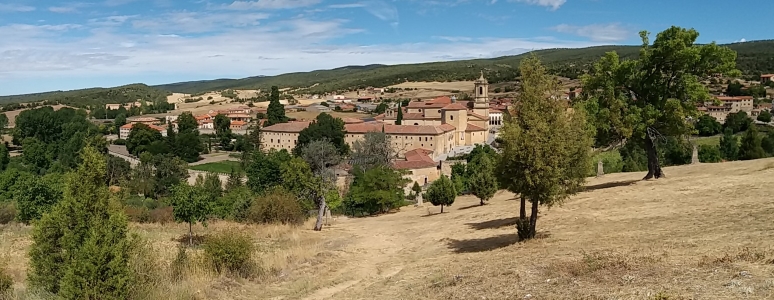
Campos de Castilla
By Br Pablo Rodríguez Jordá | Br Pablo shares his reflections on the feast of St John Macías, a Dominican saint who was a shepherd in his youth and learned the secrets of prayer in his long hours contemplating the landscape.
View of the Benedictine Abbey of St Dominic of Silos
Campos de Castilla is the name of a famous poetry collection by the 20th century Spanish writer Antonio Machado, who attempted to immortalise in verse one of the most iconic landscapes of the Iberian Peninsula: the fields of Castile.
Soria’s earth is dry and cold.
Among the hills and bare sierras,
green meadows, ashen slopes,
spring comes
scattering small white daisies
over the fragrant grasses.
The earth’s not alive, the land dreams.
At the start of April, snow
covers Moncayo’s shoulder:
the traveller winds a scarf
round neck and throat, and shepherds pass
wrapped up in their long capes.
Today the Dominicans celebrate the feast of St John Macías, who was born in these lands in the 16th century and spent his youth as a shepherd, before entering the Order of Preachers and becoming a lay brother. It is said that the long hours looking after his sheep and watching the landscape taught him the secrets of contemplation. One day, meditating on the words of the Apocalypse ‘I saw a new heaven and a new earth’, he decided to set sail for Peru, the place where he and his contemporaries Rose of Lima and Martin de Porres would become saints.

The city of Avila
St Teresa of Avila and St John of the Cross, who lived around the same time as St John Macías, are also said to have been enraptured by the contemplation of these vast plains, and even to have drawn some of their mystical impulse from it. Could there be something about a landscape that leads a person to encounter God? The question occupied my thoughts during my last visit to Castile, which certainly had a contemplative goal: to spend a few days on retreat in the Benedictine Abbey of St Dominic of Silos.

St Dominic of Silos
Silos is full of significance for a Dominican. If visiting the tiny nearby village of Caleruega, St Dominic’s birthplace, means returning to the very beginning of the Dominican Order, travelling to Silos feels like stepping back to its threshold. Here came once St Dominic’s mother, Jane of Aza, troubled by the pain and difficulties of her third pregnancy, and by a decidedly strange dream that seemed to foretell she was carrying a torch-bearing dog that would set the world ablaze. She came in pilgrimage to Silos seeking the intercession of St Dominic, a renowned abbot buried in the monastery and canonised shortly after his death. After praying, it was revealed to her she would give birth to a great saint that would become a light for the Church. In gratitude, she named her child Dominic. So goes the legend.

The cloister in Silos
The Abbey goes as far back as the 10th century. In fact, some of the famous art that has been preserved in its cloister dates from around 1050, when England had not yet been conquered by the Normans and Gothic was still to be invented:

Jesus appears to St Thomas and the other disciples

The Road to Emmaus
As I was travelling to Silos, looking at the landscape, I remembered a conversation I had had a few days before with a friend who is an agnostic. He asked me what reasons I had to be a Christian, and as I tried to set forth my case, it became evident to me that there is an essential aspect of Christianity that is too often forgotten – that beyond a faith, a creed, a religion, even a way of life if you wish, Christianity is, crucially, something that happened, an event that took place in our time – that is, in our world, in the shared history that has come down to us, down to our day. It dawns on us only in fleeting moments of particular insight, when we remember that professing ‘God became man’ is asserting something that really happened.
God entered human history, and wherever Christ was proclaimed, history took an irreversible turn. As I looked at the Castilian plains, I realised that even the countryside still bears the marks of that singular event. This can still be seen in the landscape of many European countries, where monasteries have tamed and adorned the bare wilderness, or where the spires of country churches still tower above the horizon. I spent some time walking on top of one of the hills that dominates the view over Silos (the photo that heads this post), trying to imagine the originally unpopulated valley and the wild shrubs by the riverside; then, the first monks arriving, settling near the river; the first bridges and mills built; the land diligently tilled; and in time, a little village developing around the monastery walls.

A statue of Mary overlooking the valley of Silos
It is perhaps the silent appeal of the wilderness, its immensity and bareness, not unlike the land where our Lord walked, what moved the heart of many a mystic to leave everything behind and give themselves to God; what led John Macías to renounce this familiar sight for ‘a new heaven and a new earth’, and Teresa of Avila and John of the Cross to enter the cloister. And the encounter not only transformed them. It also changed the landscape, which still bears the mark of the Cross, and where the echo of Christ’s words resounds to this day: “truly I say to you, if you have faith the size of a mustard seed, you will say to this mountain, ‘Move from here to there,’ and it will move”.
MORE ON: DOMINICANS, DOMINICAN HISTORY, PRAYER, SAINTS


